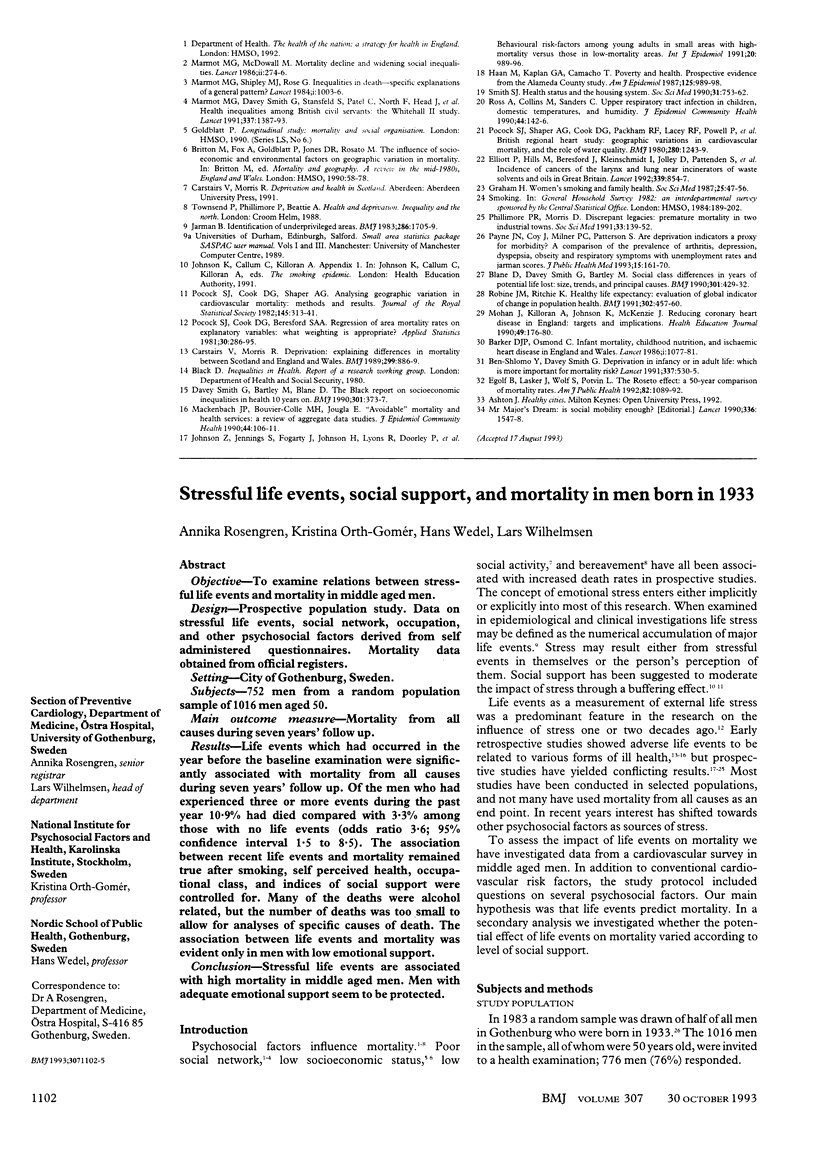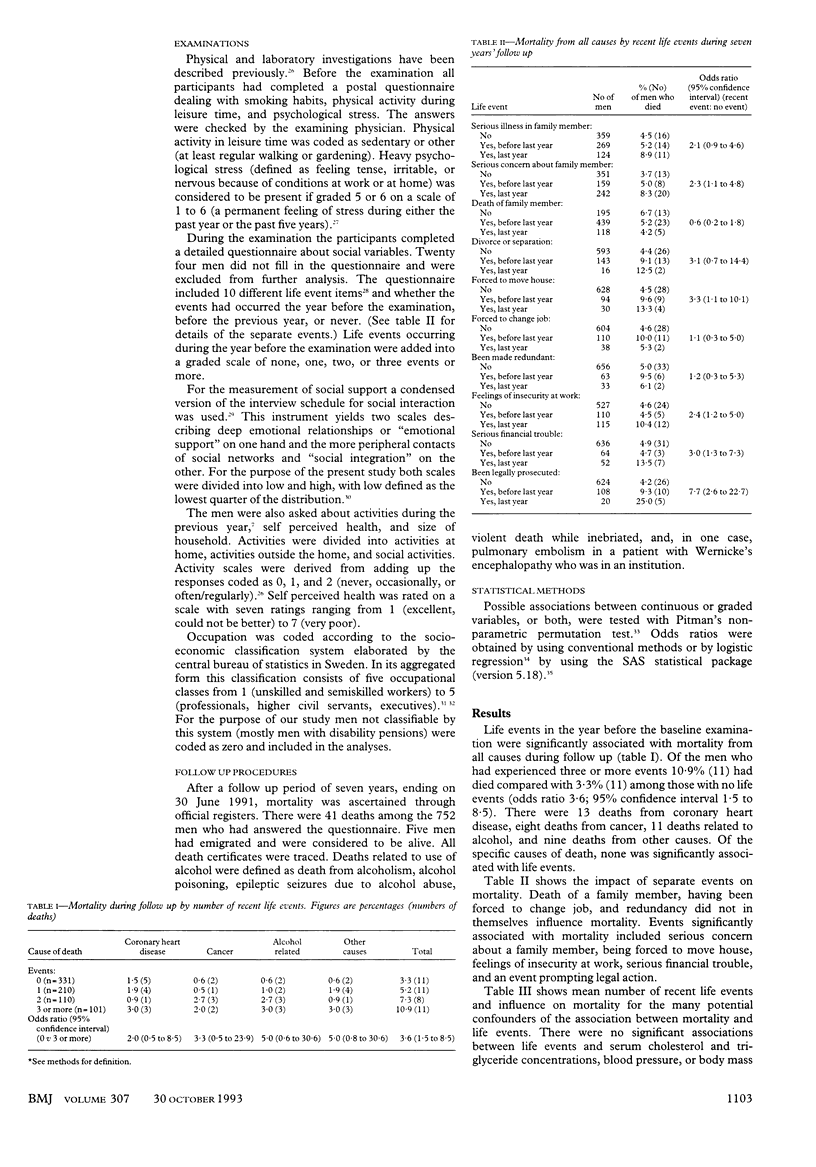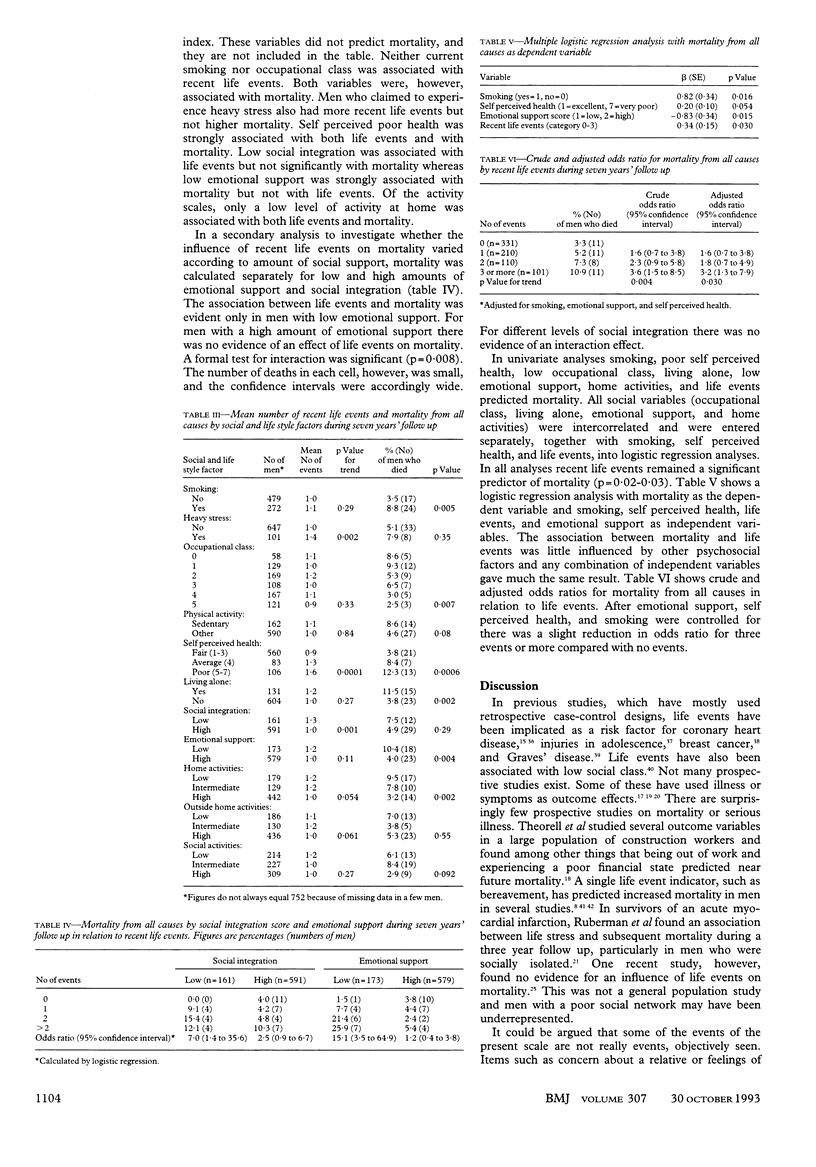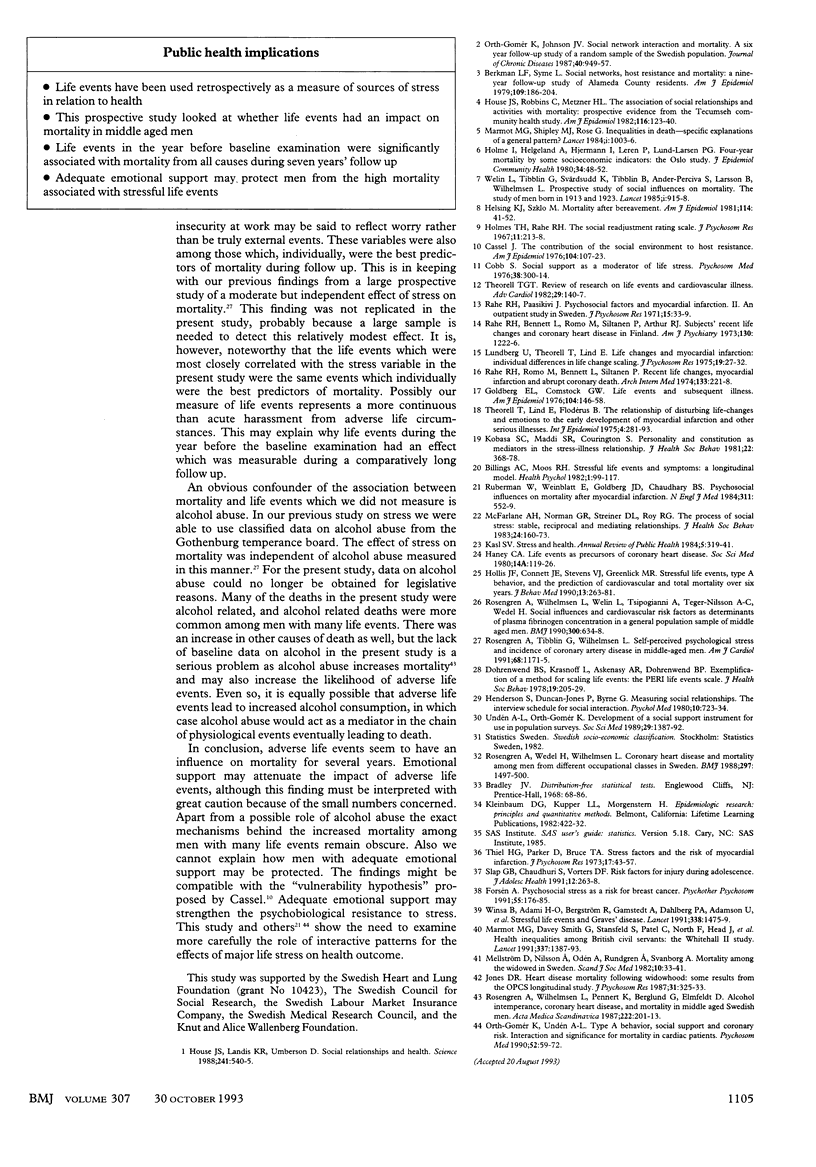Abstract
OBJECTIVE--To examine relations between stressful life events and mortality in middle aged men. DESIGN--Prospective population study. Data on stressful life events, social network, occupation, and other psychosocial factors derived from self administered questionnaires. Mortality data obtained from official registers. SETTING--City of Gothenburg, Sweden. SUBJECTS--752 men from a random population sample of 1016 men aged 50. MAIN OUTCOME MEASURE--Mortality from all causes during seven years' follow up. RESULTS--Life events which had occurred in the year before the baseline examination were significantly associated with mortality from all causes during seven years' follow up. Of the men who had experienced three or more events during the past year 10.9% had died compared with 3.3% among those with no life events (odds ratio 3.6; 95% confidence interval 1.5 to 8.5). The association between recent life events and mortality remained true after smoking, self perceived health, occupational class, and indices of social support were controlled for. Many of the deaths were alcohol related, but the number of deaths was too small to allow for analyses of specific causes of death. The association between life events and mortality was evident only in men with low emotional support. CONCLUSION--Stressful life events are associated with high mortality in middle aged men. Men with adequate emotional support seem to be protected.
Full text
PDF



Selected References
These references are in PubMed. This may not be the complete list of references from this article.
- Berkman L. F., Syme S. L. Social networks, host resistance, and mortality: a nine-year follow-up study of Alameda County residents. Am J Epidemiol. 1979 Feb;109(2):186–204. doi: 10.1093/oxfordjournals.aje.a112674. [DOI] [PubMed] [Google Scholar]
- Cassel J. The contribution of the social environment to host resistance: the Fourth Wade Hampton Frost Lecture. Am J Epidemiol. 1976 Aug;104(2):107–123. doi: 10.1093/oxfordjournals.aje.a112281. [DOI] [PubMed] [Google Scholar]
- Cobb S. Presidential Address-1976. Social support as a moderator of life stress. Psychosom Med. 1976 Sep-Oct;38(5):300–314. doi: 10.1097/00006842-197609000-00003. [DOI] [PubMed] [Google Scholar]
- Forsén A. Psychosocial stress as a risk for breast cancer. Psychother Psychosom. 1991;55(2-4):176–185. doi: 10.1159/000288427. [DOI] [PubMed] [Google Scholar]
- Goldberg E. L., Comstock G. W. Life events and subsequent illness. Am J Epidemiol. 1976 Aug;104(2):146–158. doi: 10.1093/oxfordjournals.aje.a112285. [DOI] [PubMed] [Google Scholar]
- Helsing K. J., Szklo M. Mortality after bereavement. Am J Epidemiol. 1981 Jul;114(1):41–52. doi: 10.1093/oxfordjournals.aje.a113172. [DOI] [PubMed] [Google Scholar]
- Hollis J. F., Connett J. E., Stevens V. J., Greenlick M. R. Stressful life events, Type A behavior, and the prediction of cardiovascular and total mortality over six years. MRFIT Group. J Behav Med. 1990 Jun;13(3):263–280. doi: 10.1007/BF00846834. [DOI] [PubMed] [Google Scholar]
- Holme I., Helgeland A., Hjermann I., Leren P., Lund-Larsen P. G. Four-year mortality by some socioeconomic indicators: the Oslo study. J Epidemiol Community Health. 1980 Mar;34(1):48–52. doi: 10.1136/jech.34.1.48. [DOI] [PMC free article] [PubMed] [Google Scholar]
- Holmes T. H., Rahe R. H. The Social Readjustment Rating Scale. J Psychosom Res. 1967 Aug;11(2):213–218. doi: 10.1016/0022-3999(67)90010-4. [DOI] [PubMed] [Google Scholar]
- House J. S., Landis K. R., Umberson D. Social relationships and health. Science. 1988 Jul 29;241(4865):540–545. doi: 10.1126/science.3399889. [DOI] [PubMed] [Google Scholar]
- House J. S., Robbins C., Metzner H. L. The association of social relationships and activities with mortality: prospective evidence from the Tecumseh Community Health Study. Am J Epidemiol. 1982 Jul;116(1):123–140. doi: 10.1093/oxfordjournals.aje.a113387. [DOI] [PubMed] [Google Scholar]
- Jones D. R. Heart disease mortality following widowhood: some results from the OPCS Longitudinal Study. Office of Population Censuses and Surveys. J Psychosom Res. 1987;31(3):325–333. doi: 10.1016/0022-3999(87)90052-3. [DOI] [PubMed] [Google Scholar]
- Kasl S. V. Stress and health. Annu Rev Public Health. 1984;5:319–341. doi: 10.1146/annurev.pu.05.050184.001535. [DOI] [PubMed] [Google Scholar]
- Kobasa S. C., Maddi S. R., Courington S. Personality and constitution as mediators in the stress-illness relationship. J Health Soc Behav. 1981 Dec;22(4):368–378. [PubMed] [Google Scholar]
- Marmot M. G., Shipley M. J., Rose G. Inequalities in death--specific explanations of a general pattern? Lancet. 1984 May 5;1(8384):1003–1006. doi: 10.1016/s0140-6736(84)92337-7. [DOI] [PubMed] [Google Scholar]
- Marmot M. G., Smith G. D., Stansfeld S., Patel C., North F., Head J., White I., Brunner E., Feeney A. Health inequalities among British civil servants: the Whitehall II study. Lancet. 1991 Jun 8;337(8754):1387–1393. doi: 10.1016/0140-6736(91)93068-k. [DOI] [PubMed] [Google Scholar]
- McFarlane A. H., Norman G. R., Streiner D. L., Roy R. G. The process of social stress: stable, reciprocal, and mediating relationships. J Health Soc Behav. 1983 Jun;24(2):160–173. [PubMed] [Google Scholar]
- Mellström D., Nilsson A., Odén A., Rundgren A., Svanborg A. Mortality among the widowed in Sweden. Scand J Soc Med. 1982;10(2):33–41. doi: 10.1177/140349488201000201. [DOI] [PubMed] [Google Scholar]
- Orth-Gomér K., Johnson J. V. Social network interaction and mortality. A six year follow-up study of a random sample of the Swedish population. J Chronic Dis. 1987;40(10):949–957. doi: 10.1016/0021-9681(87)90145-7. [DOI] [PubMed] [Google Scholar]
- Orth-Gomér K., Undén A. L. Type A behavior, social support, and coronary risk: interaction and significance for mortality in cardiac patients. Psychosom Med. 1990 Jan-Feb;52(1):59–72. doi: 10.1097/00006842-199001000-00005. [DOI] [PubMed] [Google Scholar]
- Rahe R. H., Bennett L., Romo M., Siltanen P., Arthur R. J. Subjects' recent life changes and coronary heart disease in Finland. Am J Psychiatry. 1973 Nov;130(11):1222–1226. doi: 10.1176/ajp.130.11.1222. [DOI] [PubMed] [Google Scholar]
- Rahe R. H., Paasikivi J. Psychosocial factors and myocardial infarction. II. An outpatient study in Sweden. J Psychosom Res. 1971 Mar;15(1):33–39. doi: 10.1016/0022-3999(71)90071-7. [DOI] [PubMed] [Google Scholar]
- Rahe R. H., Romo M., Bennett L., Siltanen P. Recent life changes, myocardial infarction, and abrupt coronary death. Studies in Helsinki. Arch Intern Med. 1974 Feb;133(2):221–228. [PubMed] [Google Scholar]
- Rosengren A., Wedel H., Wilhelmsen L. Coronary heart disease and mortality in middle aged men from different occupational classes in Sweden. BMJ. 1988 Dec 10;297(6662):1497–1500. doi: 10.1136/bmj.297.6662.1497. [DOI] [PMC free article] [PubMed] [Google Scholar]
- Rosengren A., Wilhelmsen L., Pennert K., Berglund G., Elmfeldt D. Alcoholic intemperance, coronary heart disease and mortality in middle-aged Swedish men. Acta Med Scand. 1987;222(3):201–213. doi: 10.1111/j.0954-6820.1987.tb10661.x. [DOI] [PubMed] [Google Scholar]
- Rosengren A., Wilhelmsen L., Welin L., Tsipogianni A., Teger-Nilsson A. C., Wedel H. Social influences and cardiovascular risk factors as determinants of plasma fibrinogen concentration in a general population sample of middle aged men. BMJ. 1990 Mar 10;300(6725):634–638. doi: 10.1136/bmj.300.6725.634. [DOI] [PMC free article] [PubMed] [Google Scholar]
- Ruberman W., Weinblatt E., Goldberg J. D., Chaudhary B. S. Psychosocial influences on mortality after myocardial infarction. N Engl J Med. 1984 Aug 30;311(9):552–559. doi: 10.1056/NEJM198408303110902. [DOI] [PubMed] [Google Scholar]
- Slap G. B., Chaudhuri S., Vorters D. F. Risk factors for injury during adolescence. J Adolesc Health. 1991 May;12(3):263–268. doi: 10.1016/0197-0070(91)90021-d. [DOI] [PubMed] [Google Scholar]
- Theorell T. G. Review of research on life events and cardiovascular illness. Adv Cardiol. 1982;29:140–149. doi: 10.1159/000406209. [DOI] [PubMed] [Google Scholar]
- Thiel H. G., Parker D., Bruce T. A. Stress factors and the risk of myocardial infarction. J Psychosom Res. 1973 Jan;17(1):43–57. doi: 10.1016/0022-3999(73)90086-x. [DOI] [PubMed] [Google Scholar]
- Undén A. L., Orth-Gomér K. Development of a social support instrument for use in population surveys. Soc Sci Med. 1989;29(12):1387–1392. doi: 10.1016/0277-9536(89)90240-2. [DOI] [PubMed] [Google Scholar]
- Welin L., Tibblin G., Svärdsudd K., Tibblin B., Ander-Peciva S., Larsson B., Wilhelmsen L. Prospective study of social influences on mortality. The study of men born in 1913 and 1923. Lancet. 1985 Apr 20;1(8434):915–918. doi: 10.1016/s0140-6736(85)91684-8. [DOI] [PubMed] [Google Scholar]
- Winsa B., Adami H. O., Bergström R., Gamstedt A., Dahlberg P. A., Adamson U., Jansson R., Karlsson A. Stressful life events and Graves' disease. Lancet. 1991 Dec 14;338(8781):1475–1479. doi: 10.1016/0140-6736(91)92298-g. [DOI] [PubMed] [Google Scholar]


